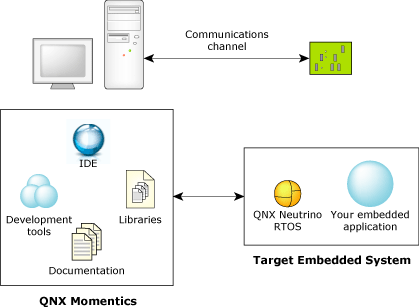![[Previous]](prev.gif) |
![[Contents]](contents.gif) |
![[Index]](keyword_index.gif) |
![[Next]](next.gif) |
![[Previous]](prev.gif) |
![[Contents]](contents.gif) |
![[Index]](keyword_index.gif) |
![[Next]](next.gif) |
 |
This version of this document is no longer maintained. For the latest documentation, see http://www.qnx.com/developers/docs. |
This chapter includes:
Thank you for choosing the QNX Software Development Platform. It includes everything you need to build and maintain your QNX Neutrino-based embedded system:
Board support packages (BSPs), driver development kits (DDKs), and QNX Aviage middleware packages are available separately; you can download them from our website, http://www.qnx.com/.
Trusted and proven in countless embedded systems, QNX Neutrino has a growing reputation as the world's most reliable RTOS. We now invite you to explore the advanced tools that the QNX Momentics Tool Suite adds to QNX Neutrino.

QNX Momentics is the development environment on your host for the QNX Neutrino RTOS running on your target.
This guide is intended to introduce you to the QNX Momentics Tool Suite and help you start developing applications for QNX Neutrino. This guide is organized around these main topics:
The following table may help you quickly find information in this guide:
| To: | Go to: |
|---|---|
| See a list of this product's components | “QNX Momentics at a glance” in What is QNX Momentics? |
| Understand the license agreement | “A word about licensing” in What is QNX Momentics? |
| Use a virtual machine | “Getting started before you have your target” in What is QNX Momentics? |
| Install QNX Momentics on your host machine or remove it | “Installing and removing QNX Momentics” in Getting Started |
| Find out where components are installed on your host machine | “What did I just install?” in Getting Started |
| Upgrade your software | “Upgrading your software” in Getting Started |
| Run the QNX Neutrino RTOS on a target machine | “Running QNX Neutrino on a target machine” in Getting Started |
| Get started with the documentation | How to Get Help |
| Get technical support | How to Get Help |
| Find the meaning of terms used in QNX documentation | Glossary |
| Look up a word in this guide's keyword index | Index |
Throughout this manual, we use certain typographical conventions to distinguish technical terms. In general, the conventions we use conform to those found in IEEE POSIX publications. The following table summarizes our conventions:
| Reference | Example |
|---|---|
| Code examples | if( stream == NULL ) |
| Command options | -lR |
| Commands | make |
| Environment variables | PATH |
| File and pathnames | /dev/null |
| Function names | exit() |
| Keyboard chords | Ctrl-Alt-Delete |
| Keyboard input | something you type |
| Keyboard keys | Enter |
| Program output | login: |
| Programming constants | NULL |
| Programming data types | unsigned short |
| Programming literals | 0xFF, "message string" |
| Variable names | stdin |
| User-interface components | Cancel |
We use an arrow (→) in directions for accessing menu items, like this:
You'll find the Other... menu item under .
We use notes, cautions, and warnings to highlight important messages:
 |
Notes point out something important or useful. |
 |
Cautions tell you about commands or procedures that may have unwanted or undesirable side effects. |
 |
Warnings tell you about commands or procedures that could be dangerous to your files, your hardware, or even yourself. |
In our documentation, we use a forward slash (/) as a delimiter in all pathnames, including those pointing to Windows files.
We also generally follow POSIX/UNIX filesystem conventions.
At the top and bottom of our HTML docs, you'll see some or all of these buttons:
| Use this button: | To move: |
|---|---|

|
To the previous part of the document. |

|
“Up” in the document:
|

|
To the keyword index. |

|
To the next part of the document. |
Copyright © 2004–2009, QNX Software Systems GmbH & Co. KG. All rights reserved.
![[Previous]](prev.gif) |
![[Contents]](contents.gif) |
![[Index]](keyword_index.gif) |
![[Next]](next.gif) |